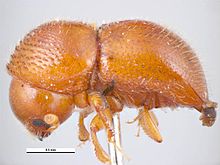Xylosandrus morigerus
| Xyleborus morigerus | |
|---|---|

| |
| Scientific classification | |
| Kingdom: | |
| Phylum: | |
| Class: | |
| Order: | |
| Suborder: | |
| Superfamily: | |
| Family: | |
| Genus: | |
| Species: | X. morigerus |
| Binomial name | |
| Xylosandrus morigerus (Blanford, 1894) | |
| Synonyms | |
| |
Xylosandrus morigerus, is a species of weevil widespread throughout Afrotropical, Australian, Neotropical, Oceania and Oriental regions. It is also introduced to Palearctic regional countries.[1][2]
Distribution
It is native to Gabon, Madagascar, Mauritius, Zaire, Australia, New Guinea, Solomon Islands, India, Sri Lanka, Indonesia, Malaysian Peninsula, Philippines, Taiwan, Vietnam, Brazil, Colombia, Costa Rica, Galapagos Islands, Honduras, Mexico, Panama, Puerto Rico, Tobago, Venezuela, Fiji islands, Hawaii, Micronesia, Samoa, and Tonga.[3][4] It is also found in Austria, Czech republic, United Kingdom, France, Italy, Jordan and Lebanon as an exotic species.[5][6]
Description
Body length of the female ranges from 1.5 to 2.0 mm. Body light to dark brown. Antennae and legs are yellowish brown. Antennea with 5 funicular segments and obliquely truncate club. Pronotal vestiture is semi-appressed and with hairy setae. Pronotal base covered with a dense patch of short erect setae that resemble a pronotal-mesonotal mycangium. Pronotal disc is moderately punctate. Pronotum consists with lateral costa and carina. Protibiae with 4 socketed teeth, whereas mesotibiae with 8 to 10 and metatibiae with 10 socketed teeth. In elytra, discal striae and interstriae uniseriate are punctate. Declivital elytral face is convex, steep and abruptly separated from disc.[7]
Biology
The species shows successful inbreeding. Mating occurs between siblings and before dispersal, which assures successful insemination of most dispersing females. Females that are not inseminated by a brother called haplodiploid, can potentially mate with a haploid son produced from unfertilized eggs before leaving the nest. The genetic variation suggests that outbreeding is extremely rare in the species.[8]
A polyphagous species, it is found in many plants.[7] It shows a tight symbiosis with ambrosia fungi such as Ambrosiella and occasionally other imperfect ascomycete fungi.[9]
Host plants
- Acacia gaumeri
- Acalypha
- Actinophora fragrans
- Adenanthera pavonina
- Albizia glauca
- Albizia procera
- Alseis yucatanensis
- Altingia excelsa
- Arthrophyllum diversifolium
- Amomum
- Aspidosperma
- Astronium graveolens
- Bixa orellana
- Boehmeria
- Bridelia
- Brosimum alicastrum
- Bursera simaruba
- Butea monosperma
- Calamus caesius
- Calophyllum brasiliense
- Camellia sinensis
- Cassia multijuga
- Castanea argentea
- Castanopsis
- Cattleya
- Cedrela odorata
- Cecropia obtusifolia
- Ceiba pentandra
- Centrosema plumieri
- Chrysophyllum cainito
- Cinchona
- Claoxylon polot
- Clidemia hirta
- Cocos nucifera
- Coffea arabica
- Coffea excelsa
- Coffea liberica
- Cola acuminata
- Cordia dodecandra
- Crotalaria anagyroides
- Crotalaria usaramoensis
- Dalbergia latifolia
- Dendrobium phalaenopsis
- Dendrobium superbum
- Dendrobium veratrifolium
- Derris microphylla
- Didymopanax
- Dryobalanops oblongifolia
- Endospermum diadenum
- Epidendrum stamfordianum
- Erythrina lithosperma
- Erythroxylum novogranatense
- Esenbeckia pentaphylla
- Eupatorium pallescens
- Eusideroxylon zwageri
- Falcataria moluccana
- Ficus ampelos
- Flemingia strobilifera
- Freycinetia hombroni
- Fuchsia
- Glochidion
- Grewia laevigata
- Gynotroches onilaris
- Hevea brasiliensis
- Intsia palembanica
- Lecythis
- Leucaena glauca
- Licania hypoleuca
- Lonicera caprifolium
- Macaranga
- Machaerium cirrhiferum
- Marumia muscosa
- Melia azedarach
- Miconia trinervia
- Mitrella kentii
- Ochroma lagopus
- Persea gratissima
- Phalaenopsis
- Pometia pinnata
- Pouteria sapota
- Quararibea
- Renanthera storiei
- Sambucus javanica
- Schizolobium parahyba
- Schleichera oleosa
- Serjania
- Shorea leprosula
- Spondias mombin
- Swietenia macrophylla
- Swietenia mahagoni
- Syzygium polyanthum
- Tabebuia rosea
- Tarenna incerta
- Tectona grandis
- Tephrosia maxima
- Tephrosia vogelii
- Thea sinensis
- Theobroma cacao
- Terminalia amazonia
- Trema micrantha
- Trema orientalis
- Vanda coerulea
- Vanda teres
- Vanda tricolor
- Vitis
References
- ^ Dole, Stephanie A.; Jordal, Bjarte H.; Cognato, Anthony I. (2010-03-01). "Polyphyly of Xylosandrus Reitter inferred from nuclear and mitochondrial genes (Coleoptera: Curculionidae: Scolytinae)". Molecular Phylogenetics and Evolution. 54 (3): 773–782. doi:10.1016/j.ympev.2009.11.011. PMID 19925873. Retrieved 2021-09-06.
- ^ "Insect pests of Mahogany in Indonesia and Malaysia". www.cabdirect.org. Retrieved 2021-09-06.
- ^ "A study of the twig borer Xyleborus morigerus Blandford, mainly based on observations in Java". www.cabdirect.org. Retrieved 2021-09-06.
- ^ Cognato, Anthony I.; Rubinoff, Daniel (September 2008). "New Exotic Ambrosia Beetles Found in Hawaii (Curculionidae: Scolytinae: Xyleborina)". The Coleopterists Bulletin. 62 (3): 421–424. doi:10.1649/1084.1. S2CID 84315415. Retrieved 2021-09-06.
- ^ "Les Scolytes du genre Xylosandrus en France (Coleoptera Curculionidae Scolytinae)". L’Entomologiste, tome 71, 2015, n° 4 : 267 – 271. Retrieved 2021-09-05.
- ^ "Atratividade de substancias e de ramos de cacaueiro sobre Xylosandrus morigerus (Blandford, 1894) (Coleoptera, Scolytidae)". Revista Theobroma (Brasil). v. 16(3) p. 155-160. Retrieved 2021-09-06.
- ^ a b "Phylogenetic revision of Xylosandrus Reitter (Coleoptera: Curculionidae: Scolytinae: Xyleborina)". Proceedings of the California Academy of Sciences Volume: 61 :451-545. Retrieved 2021-09-05.
- ^ Andersen, Hanne F.; Jordal, Bjarte H.; Kambestad, Marius; Kirkendall, Lawrence R. (2012). "Improbable but true: the invasive inbreeding ambrosia beetle Xylosandrus morigerus has generalist genotypes". Ecology and Evolution. 2 (1): 247–257. Bibcode:2012EcoEv...2..247A. doi:10.1002/ece3.58. PMC 3297192. PMID 22408740.
- ^ Beaver, R. A. (1987-01-01). "The bark and ambrosia beetles (Coleoptera: Scolytidae and Platypodidae) of Tonga". New Zealand Entomologist. 9 (1): 64–70. Bibcode:1987NZEnt...9...64B. doi:10.1080/00779962.1987.9722496. Retrieved 2021-09-06.
